One Impossibly Crazy
2010 7-Imp Retrospective Before Breakfast
 December 30th, 2010 by jules
December 30th, 2010 by jules
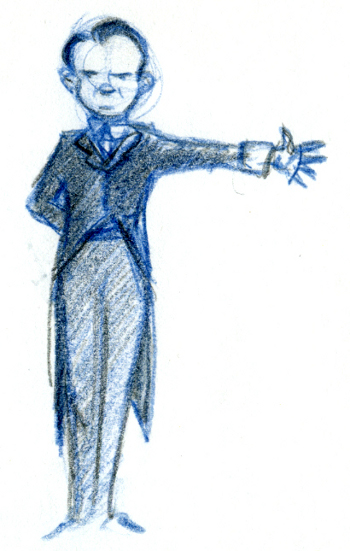 Alfred and I are here to look back on What Happened at 7-Imp in 2010. I’ve done this for the past two years every December, and—as I explained last year—I question my own sanity when I pull together posts like this, since it’s not a trivial thing to do and takes quite a bit of time I could use, say, sleeping instead. Well, this is way more fun than napping, I say, not to mention that, for some inexplicable reason, I find strangely beguiling at the end of every year those retrospective round-ups and best-of lists of all sorts that one sees everywhere—both online and in print—about entertainment and literature and politics and on and on. Ill say it again: Creating one of my own, looking back at who visited the 7-Imp salon in 2010, is my warped idea of fun, tidy fun. And these recaps are crazy long, yes. But they’re for browsing. Good-times browsing.
Alfred and I are here to look back on What Happened at 7-Imp in 2010. I’ve done this for the past two years every December, and—as I explained last year—I question my own sanity when I pull together posts like this, since it’s not a trivial thing to do and takes quite a bit of time I could use, say, sleeping instead. Well, this is way more fun than napping, I say, not to mention that, for some inexplicable reason, I find strangely beguiling at the end of every year those retrospective round-ups and best-of lists of all sorts that one sees everywhere—both online and in print—about entertainment and literature and politics and on and on. Ill say it again: Creating one of my own, looking back at who visited the 7-Imp salon in 2010, is my warped idea of fun, tidy fun. And these recaps are crazy long, yes. But they’re for browsing. Good-times browsing.
I know Alfred looks slightly sinister and surly, but he really enjoys these, too. He just takes it very seriously.
So, what was new to 7-Imp in 2010? This is how I see it:
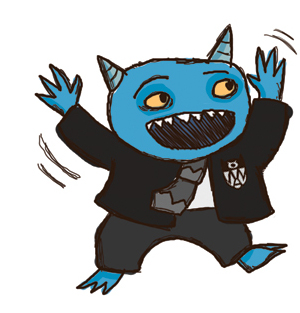 Well, first, how thrilling is it that 7-Imp now has its own mascot? Very. That blue guy’s name is 7-Imp. He is one of the monsters from Tammi Sauer’s and Scott Magoon’s picture book Mostly Monsterly, published in Fall 2010. In this roundtable discussion, Scott told me and my 7-Imp readers that, while he worked on the book, he had named that little guy “7-Imp.” I found it inordinately exciting that the blog went down in picture book history like that, even if his name doesn’t actually appear in the book. Thus, I declared that little impish delight from the Monster Academy the new 7-Imp mascot. Looks like he’s happy about being here.
Well, first, how thrilling is it that 7-Imp now has its own mascot? Very. That blue guy’s name is 7-Imp. He is one of the monsters from Tammi Sauer’s and Scott Magoon’s picture book Mostly Monsterly, published in Fall 2010. In this roundtable discussion, Scott told me and my 7-Imp readers that, while he worked on the book, he had named that little guy “7-Imp.” I found it inordinately exciting that the blog went down in picture book history like that, even if his name doesn’t actually appear in the book. Thus, I declared that little impish delight from the Monster Academy the new 7-Imp mascot. Looks like he’s happy about being here.
Okay, back to what was new in 7-Imp Land in 2010:
 I’ve had a little less time for blogging, since I’ve been writing all year. But I’ve still managed to keep up, and it still brings me joy to share lots of art with my readers, to invite authors and illustrators over to the 7-Imp salon for cyber-breakfast, and generally keep up with what’s happening with contemporary illustration / picture books / illustrated novels in the realm of children’s literature.
I’ve had a little less time for blogging, since I’ve been writing all year. But I’ve still managed to keep up, and it still brings me joy to share lots of art with my readers, to invite authors and illustrators over to the 7-Imp salon for cyber-breakfast, and generally keep up with what’s happening with contemporary illustration / picture books / illustrated novels in the realm of children’s literature.
 I extended an invitation in September to the very smart and effervescent Italian blogger and picture book aficionado Cristiana Clerici of The Tea Box, due to my love of international picture books and verging-on-geeky eagerness to learn more about them. She’s contributing interviews and book reviews of international picture books whenever the mood strikes her, sharing her love of books and following titles from all over — with special attention to Italy, the United States, the UK, France, Spain, and South American countries. Thus far, Cris has brought 7-Imp two reviews of Italian picture books and a wonderful interview with illustrator Eva Montanari:
I extended an invitation in September to the very smart and effervescent Italian blogger and picture book aficionado Cristiana Clerici of The Tea Box, due to my love of international picture books and verging-on-geeky eagerness to learn more about them. She’s contributing interviews and book reviews of international picture books whenever the mood strikes her, sharing her love of books and following titles from all over — with special attention to Italy, the United States, the UK, France, Spain, and South American countries. Thus far, Cris has brought 7-Imp two reviews of Italian picture books and a wonderful interview with illustrator Eva Montanari:
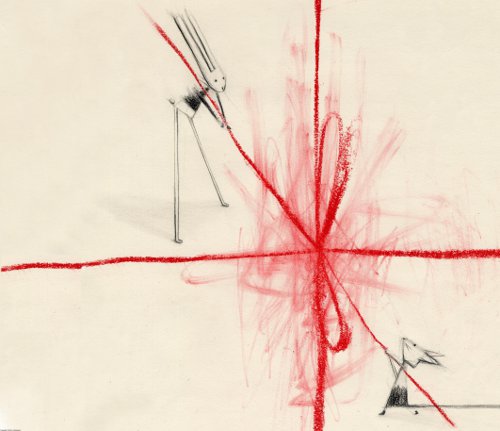
(For more information on Cris’s contributions and links to her posts, visit this page of the site.)
 2010 saw the introduction of the picture-book roundtable discussion, as mentioned above, in which the author, illustrator, editor, and art director / designer of a picture book (if available) meet to answer the same handful of questions, bringing 7-Imp readers varying perspectives on the process of creating a picture book. It all started in August with Boni Ashburn (indeed, the roundtable discussion was her smart idea), Kelly Murphy, Maggie Lehrman, and Chad W. Beckerman. They discussed March 2010’s Over at the Castle and its creation. Roundtable discussion #2 occurred in October with Tammi Sauer, Scott Magoon, and editor Alexandra Penfold discussing Mostly Monsterly.
2010 saw the introduction of the picture-book roundtable discussion, as mentioned above, in which the author, illustrator, editor, and art director / designer of a picture book (if available) meet to answer the same handful of questions, bringing 7-Imp readers varying perspectives on the process of creating a picture book. It all started in August with Boni Ashburn (indeed, the roundtable discussion was her smart idea), Kelly Murphy, Maggie Lehrman, and Chad W. Beckerman. They discussed March 2010’s Over at the Castle and its creation. Roundtable discussion #2 occurred in October with Tammi Sauer, Scott Magoon, and editor Alexandra Penfold discussing Mostly Monsterly.
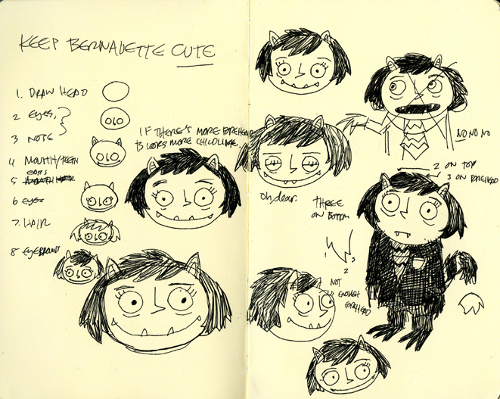
 2010 saw one more addition to the 7-Imp collection of Mad Tea Party images. This one was created specifically for 7-Imp in July 2010 by author/illustrator and graphic novelist Mark Crilley, who visited the blog in July, and I placed the image on this page of the site. (As a reminder, all the Mad Tea Party images are gathered on this page for those who want to see them all in one spot.)
2010 saw one more addition to the 7-Imp collection of Mad Tea Party images. This one was created specifically for 7-Imp in July 2010 by author/illustrator and graphic novelist Mark Crilley, who visited the blog in July, and I placed the image on this page of the site. (As a reminder, all the Mad Tea Party images are gathered on this page for those who want to see them all in one spot.)
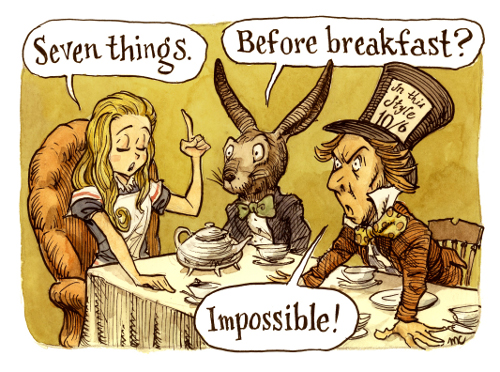
 Locally-speaking, 2010 saw the birth in October of the Nashville Kidlit Drink Night! (If it were more aptly-named, it’d be the Middle Tennessee Kidlit Drink Night, but that doesn’t have quite the ring, does it?)
Locally-speaking, 2010 saw the birth in October of the Nashville Kidlit Drink Night! (If it were more aptly-named, it’d be the Middle Tennessee Kidlit Drink Night, but that doesn’t have quite the ring, does it?)
 Lastly, I have a soft, special, squishy spot in my heart for the book featured here in November, since the editor contacted the author/illustrator, Frank W. Dormer, about doing a book after seeing his art featured here at 7-Imp years ago. 2010 saw the publication of that book. This kind of thing makes a blogger’s heart feel all swelly.
Lastly, I have a soft, special, squishy spot in my heart for the book featured here in November, since the editor contacted the author/illustrator, Frank W. Dormer, about doing a book after seeing his art featured here at 7-Imp years ago. 2010 saw the publication of that book. This kind of thing makes a blogger’s heart feel all swelly.
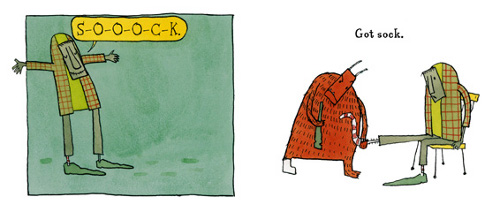
Who are some of the folks who stopped by in 2010 to have breakfast in one form or another—and coffee, of course—with me this year? Let’s get to it.
Oh, but wait. What I want to know is: Do you think there’s a Caldecott winner featured below? That’s what I’m dying to find out in January.
Author/illustrator Oliver Jeffers, who also gets my vote for Best Moustache (March 23, 2010):
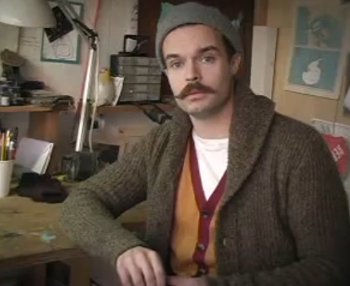 “Getting the story to flow between {a picture book’s} thirty-two pages is probably the most difficult part. It’s like directing a film, where the pace needs to be set and decisions made of what goes where. It’s at this point that many of the compositions get cut. There is a careful balance between what the pictures are showing and what the words are saying, and if something is shown, it often doesn’t need to be said. This is a great advantage of both writing and illustrating stories, as someone who just writes comes up with the entire manuscript before it is considered visually and much potential for interaction has gone.”
“Getting the story to flow between {a picture book’s} thirty-two pages is probably the most difficult part. It’s like directing a film, where the pace needs to be set and decisions made of what goes where. It’s at this point that many of the compositions get cut. There is a careful balance between what the pictures are showing and what the words are saying, and if something is shown, it often doesn’t need to be said. This is a great advantage of both writing and illustrating stories, as someone who just writes comes up with the entire manuscript before it is considered visually and much potential for interaction has gone.”
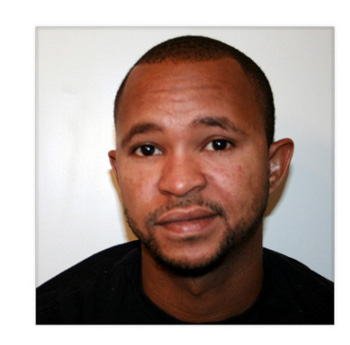 Illustrator A. G. Ford (June 1, 2010): “I think art is important to make, because creativity helps make the world go round. People need inspiration in order to create new ideas, whether it be a new invention or a new sound for music. Without each other, we can’t grow, so we must spread the energy by creating good art, and the energy will be returned to you.
Illustrator A. G. Ford (June 1, 2010): “I think art is important to make, because creativity helps make the world go round. People need inspiration in order to create new ideas, whether it be a new invention or a new sound for music. Without each other, we can’t grow, so we must spread the energy by creating good art, and the energy will be returned to you.
I think bad art would be anything that isn’t honest. Art to me doesn’t have to be done a certain way or be about a certain subject; it just has to be an honest portrayal of what the creator is going for.”
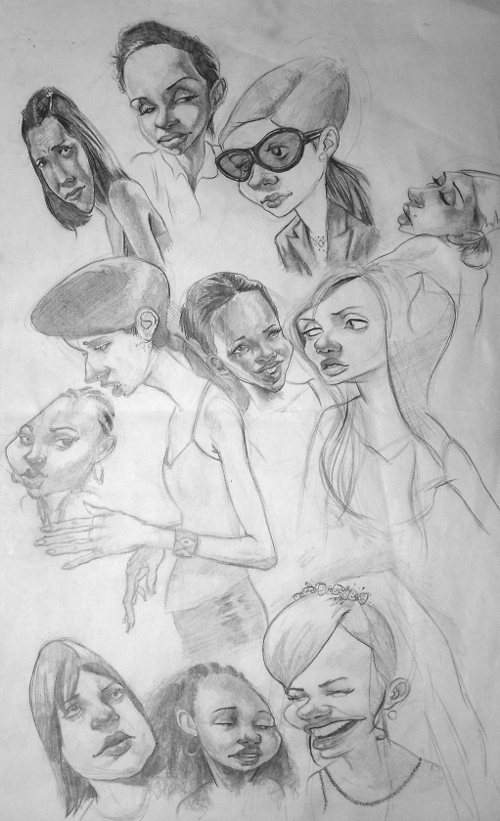
Author Candace Fleming (October 20, 2010) on Clever Jack Takes the Cake and working with illustrator G. Brian Karas:
“When my editor, Anne Schwartz, told me that Brian was going to do the illustrations for Clever Jack, I knew they’d be terrific. I’ve worked with him before, and he never disappoints. But when I saw the finished art…. Wow! Is it kosher to say I think it’s the best thing he’s ever done? The art has a charming simplicity without ever being simplistic. Does that make sense? With just a few lines and dabs of color, he manages to create an entire whimsical, timeless world. And it’s deceptive, because while it’s simple (and exactly right for the story), it’s also sophisticated.”
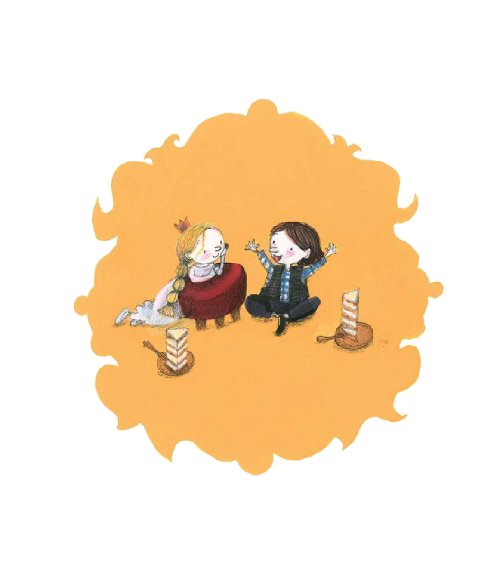
Poet Joyce Sidman (April 1, 2010): “Poetry-writing for me seems to be 90% noodling around, dreaming, taking walks, pondering, turning words over in my head; and 10% actually putting pen to paper (or fingers to keys). I wander around in a haze of longing—wanting to write, wanting to tap into that great burning river of creativity—and then, boom! One day I see my way forward and begin writing. Usually it’s a sunny day.”
illustrated by Beckie Prange
(Click to enlarge spread.)
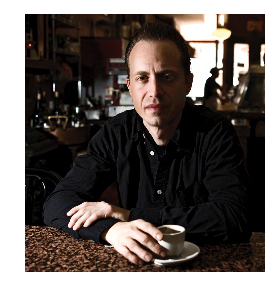 “Rocker turned colorist turned animator turned cartoonist” Mike Cavallaro (November 22, 2010): “Many years ago, I dropped out of art school, joined a band, and went touring around the States, plus a few other countries, in a van — for a period of a few years. Like other mistakes I’ve made, it seemed like a good idea at the time. I learned a few things from being in a band, like never pull $10,000 worth of equipment in a trailer you built yourself behind a van held together predominantly by duct tape. Another thing I learned was that if everyone’s playing the same notes at the same time, you’ve got a pretty boring song. Allowing each separate instrument to do what it does best amounts to a more satisfying whole than any one of them could have achieved alone. Comics are exactly the same, especially when the project is collaborative…”
“Rocker turned colorist turned animator turned cartoonist” Mike Cavallaro (November 22, 2010): “Many years ago, I dropped out of art school, joined a band, and went touring around the States, plus a few other countries, in a van — for a period of a few years. Like other mistakes I’ve made, it seemed like a good idea at the time. I learned a few things from being in a band, like never pull $10,000 worth of equipment in a trailer you built yourself behind a van held together predominantly by duct tape. Another thing I learned was that if everyone’s playing the same notes at the same time, you’ve got a pretty boring song. Allowing each separate instrument to do what it does best amounts to a more satisfying whole than any one of them could have achieved alone. Comics are exactly the same, especially when the project is collaborative…”
Author Jane Yolen (November 22, 2010) on graphic novels: “I thought, given my background writing picture books, novels, and screenplays, that doing a graphic novel would be a piece of cake: When Mark Siegel of First/Second and I shook hands over Foiled, even before he and my agent did historic battle over the terms of the contract, I thought: This is going to be fun. How hard can it be? The short answer was: It was very hard. The learning curve was huge. It turned out that all I really knew going in was how to write.”

Author/illustrator Thacher Hurd, who was joined by author/illustrator Elisa Kleven (May 13, 2010): “The Weaver has been floating in and out of my mind for many years. I found one of my original texts for the book and was surprised to see that it was typed on a typewriter, so I must have first started working on it fifteen or twenty years ago. It became a sort of buried treasure in my life, something I would work on for a while and then put back in the drawer to see what would happen, whether it would age well in the cask of my file cabinet. Over and over again I worked on it, never feeling that it was quite ready. But then slowly it began to feel like a book or like something that I would want to publish. And with that feeling came the thought that I would be thrilled if my friend Elisa Kleven would illustrate it, would bring to life the feelings that I was trying to convey. I still don’t think I understand what the book is about. Some other world? Heaven? The spirit of creativity? I don’t know, and I like the feeling that I don’t know. I can’t put the book in a little box all neatly tied up.”
Author/illustrator Elisha Cooper (March 30, 2010): “I think we pass by so many things. Writing about farms was a chance to slow down and take a closer look at what’s under our noses.”
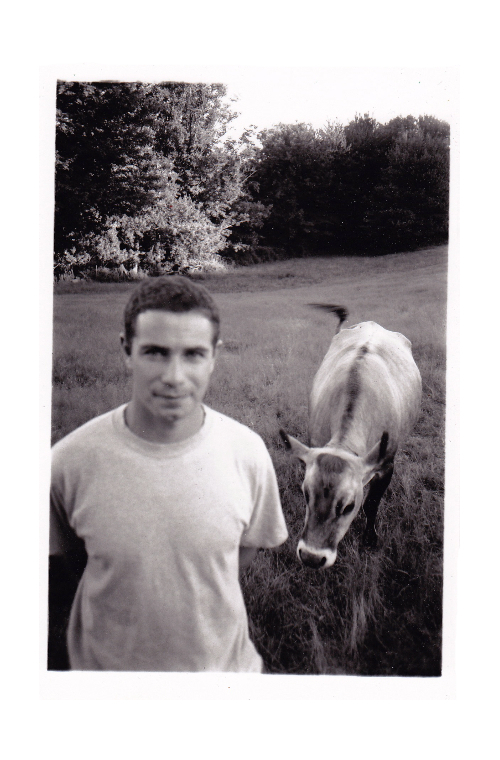
the farm is not so quiet.”
(Click to enlarge spread.)
From Elisha’s Farm.
Author Jennifer L. Holm and author/illustrator Matthew Holm (February 9, 2010):
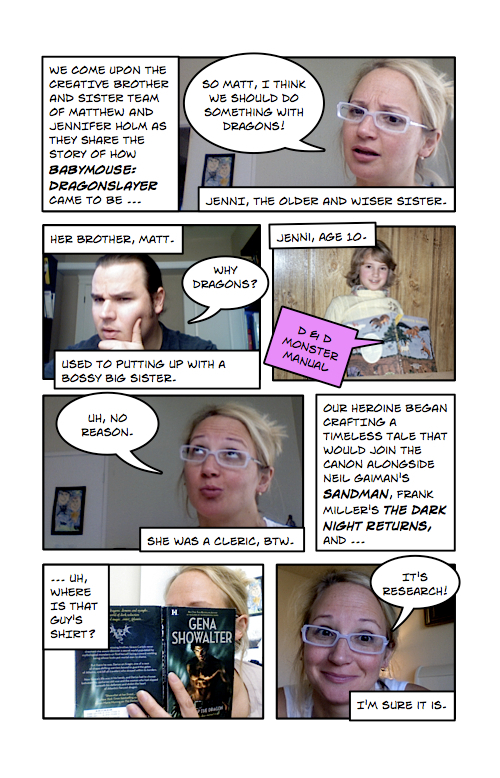
Jennifer and Matt provide an inside look at their process in creating
Babymouse: Dragonslayer.
Illustrator and paper engineer Matthew Reinhart (May 20, 2010):
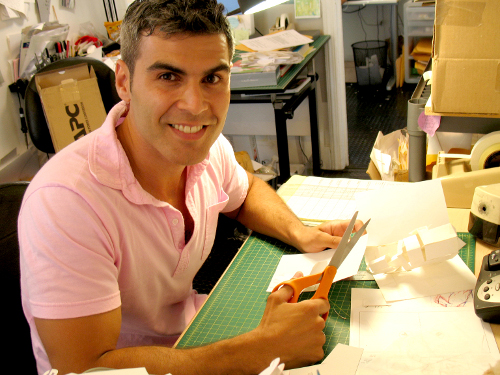
“{T}he entire process of what I do is challenging and satisfying. I can’t believe it when it’s all over and the book is sitting in my hands. I’m sort of blown away that it even came from my head…”
Illustrator Hiroe Nakata (August 24, 2010):
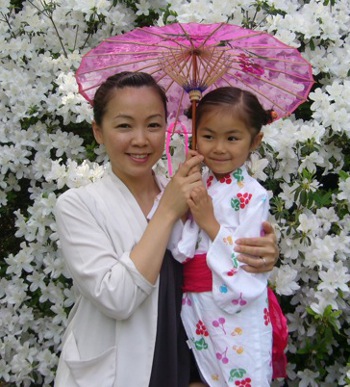 “I’d rather create my inspiration board in front of my desk, where you find my little thumbnails, but more than that, I push-pin my favorite swatch of fabrics or beautiful pieces of yarn or actual objects, like my childhood stuffed animals, leaves I found in the park, or packages. I also go though many magazines and books for correct colors. I decide on my color palette first. I think I do this because of my past experience of creating textile designs, and the color is very important in my illustrations. Then I sketch out the details while paginating the manuscripts and, from there, everything comes so smooth and easy. While I am creating the final art, I always keep in mind that I have to make everything look very fresh and whimsical because I use watercolor. I try not to create the look of overworked art. I sometimes paint several {times} the same pieces to get this perfect, fresh look. Because my style is loose and bouncy, this is very important!”
“I’d rather create my inspiration board in front of my desk, where you find my little thumbnails, but more than that, I push-pin my favorite swatch of fabrics or beautiful pieces of yarn or actual objects, like my childhood stuffed animals, leaves I found in the park, or packages. I also go though many magazines and books for correct colors. I decide on my color palette first. I think I do this because of my past experience of creating textile designs, and the color is very important in my illustrations. Then I sketch out the details while paginating the manuscripts and, from there, everything comes so smooth and easy. While I am creating the final art, I always keep in mind that I have to make everything look very fresh and whimsical because I use watercolor. I try not to create the look of overworked art. I sometimes paint several {times} the same pieces to get this perfect, fresh look. Because my style is loose and bouncy, this is very important!”
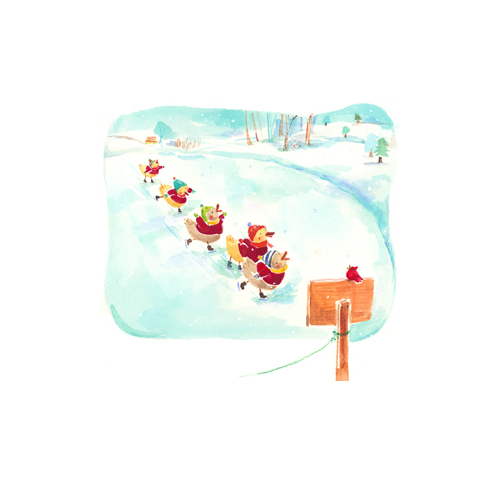
Author Chris Barton, who was joined by illustrator Tom Lichtenheld, on their Shark Vs. Train collaboration (March 15, 2010): “By the time Tom and I were done with the book, it was frightening how much time we were spending on the same wavelength. One evening, as my carpool partner drove me home from work, I made some beyond-rough sketches of how we might be able to do a Halloween scene that was giving us trouble. I was so excited by what I came up with that I called Tom before I even got home to tell him what I had in mind. I began describing the scene, and Tom suggested putting Shark in a clown hat. ‘Tom, that’s in my sketch!’ I said. Then, he suggested putting Groucho Marx glasses on Train. ‘Tom, that’s in my sketch!'”
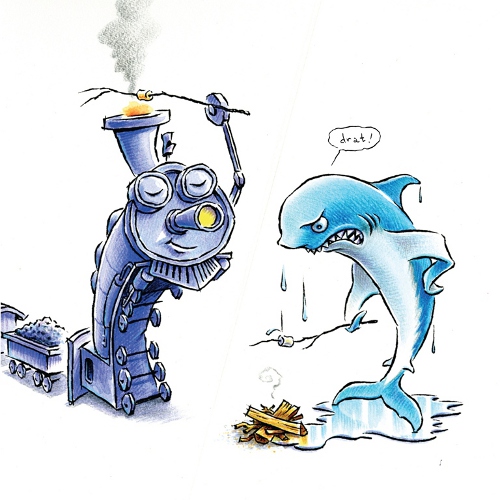
{Note: The Barton-Lichtenheld post is worth reading for many reasons, but topping those reasons is the rejected illustrations that Tom shares, the show-downs between Shark and Train that didn’t quite make it into the book.}
Illustrator Julia Denos (September 7, 2010):
 “I’m still learning how to make a book. I always wish I could say that right away I make tidy little thumbnails like they taught us to do in art school. What I really do is make a big mess, read the manuscript a million times, and whine a lot until I SEE the book. I also found that you can’t set aside time for concepting or nothing will happen but this: ‘Look at that white paper! There’s nothing on it! Should I sharpen my pencil? I want a cookie.'”
“I’m still learning how to make a book. I always wish I could say that right away I make tidy little thumbnails like they taught us to do in art school. What I really do is make a big mess, read the manuscript a million times, and whine a lot until I SEE the book. I also found that you can’t set aside time for concepting or nothing will happen but this: ‘Look at that white paper! There’s nothing on it! Should I sharpen my pencil? I want a cookie.'”
British author/illustrator Christopher Wormell (March 18, 2010): “I’ve always been a bit backward-looking—inspired more by the past than the present—and, when I was a child, some of my favourite pictures were the little wood engraved vignettes of Thomas Bewick…. When I decided to have a go at book illustration, it was to wood engraving that I turned. I hadn’t gone to college and hadn’t much idea of current trends in illustration — otherwise, I might not have decided on wood engraving. It wasn’t terribly fashionable at the time.”
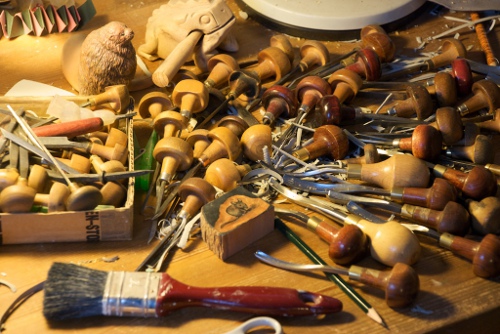
Author Alison McGhee on Bink & Gollie, co-authored with Kate DiCamillo (September 8, 2010): “I don’t think either Kate or I knew what we were doing when we decided to write a book together, but it turned out to be so dang much fun. We went into the project wanting to write about two friends, one tall, one short (no surprises there), and we tossed them a sock just to see what they’d do with it. And the whole thing went from there.”
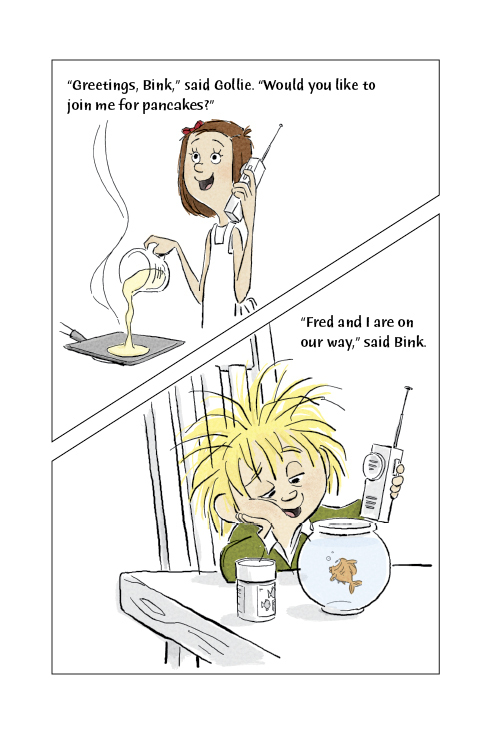
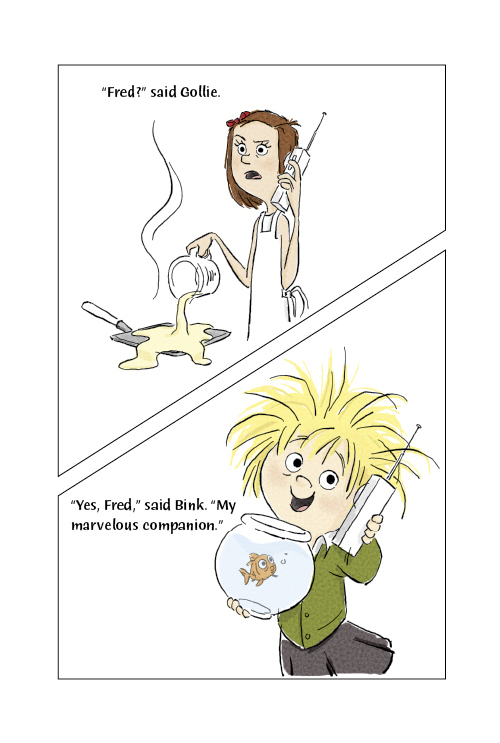
{See also this interview on April 8, 2010, with Alison. It’s sprinkled with beautiful art from Taeeun Yoo.}
Author/illustrator Peter Brown (April 20, 2010):“One of my goals now is to help nerdy-art kids understand that to make your best art you have to be inspired, and there are whole universes of inspiration waiting to be discovered within the pages of books. These days I think of reading as a huge part of my job, and every morning I sit down with my coffee and read for one to two hours. It’s probably my favorite part of the day.”

Click here to read Peter’s November-visit to 7-Imp to discuss the book further.
 Illustrator Nicole Tadgell on illustrating Becky Birtha’s Lucky Beans (March 3, 2010): “Since I was little, I’ve always wanted to do a historical book — well, let’s face it…meaning, I’d get to draw waving prairie grass and sunbonnets, because I was such a Laura Ingalls Wilder fan! But when Albert Whitman contacted me about doing a book that took place during the Depression, I still got all excited. My Dad grew up in a 1920s-style bungalow in Detroit, so I based the interior scenes from memory, as well as from dozens of research photos. Research! I always do lots of research… Just because the story takes place during the Depression didn’t mean the book had to be depressing! So, I made the clothing colors a bit brighter and showed the world as I think kids are meant to see it — a positive, loving place to learn and grow.”
Illustrator Nicole Tadgell on illustrating Becky Birtha’s Lucky Beans (March 3, 2010): “Since I was little, I’ve always wanted to do a historical book — well, let’s face it…meaning, I’d get to draw waving prairie grass and sunbonnets, because I was such a Laura Ingalls Wilder fan! But when Albert Whitman contacted me about doing a book that took place during the Depression, I still got all excited. My Dad grew up in a 1920s-style bungalow in Detroit, so I based the interior scenes from memory, as well as from dozens of research photos. Research! I always do lots of research… Just because the story takes place during the Depression didn’t mean the book had to be depressing! So, I made the clothing colors a bit brighter and showed the world as I think kids are meant to see it — a positive, loving place to learn and grow.”
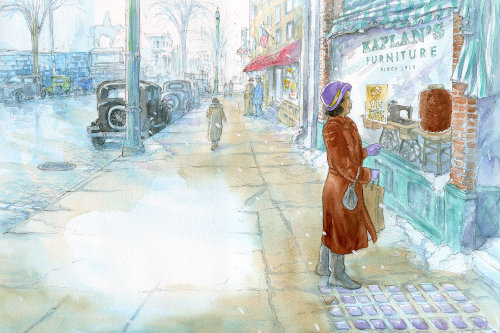
Author Cynthia Leitich Smith on writing Holler Loudly, illustrated by Barry Gott (December 1, 2010): “It took six years—with long pauses—to get it right. Two or three times, I gave up on the manuscript completely.”
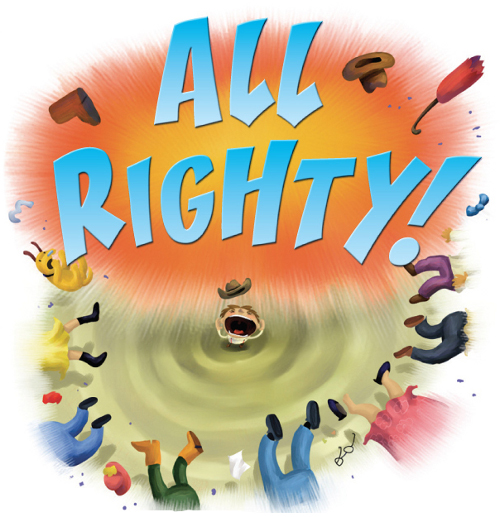
Author/illustrator Dan Santat on illustrating Mac Barnett’s Oh No!: (Or How My Science Project Destroyed the World) (June 10, 2010):“…I believe the entire {manuscript} is only 110 words? The text was so simple Mac actually had to give some instruction as to what he meant by almost every line given. So, in this image the line was, ‘looks like I’m going to have to fix this,’ and Mac’s only note was: ‘Make it a situation that is impossible to fix.’ It was very simple and still left me room for interpretation and, hence, you have an oil rig on top of a skyscraper and a No Parking sign next to it as a gag.”
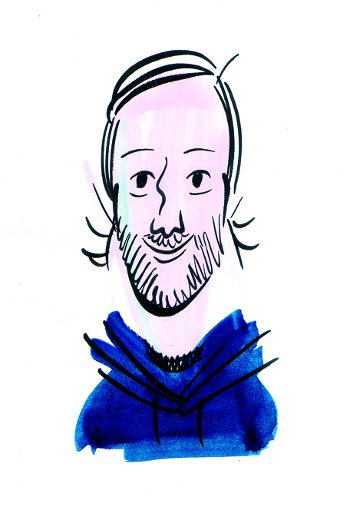 Author/illustrator Jeff Newman (February 16, 2010): “The Boys…started with a drawing of a boy dressed as an old man. Based on that character, I wrote a rough draft of a story that vaguely resembles the one in the published book. Except that it had words. Lots of words, and they weren’t very good. So, I decided to take all of them out. And that made it much better. At the same time, it completely changed my approach to the illustrations, which now had to carry the story on their own. But moving to a wordless format necessitated a streamlining of the story. There was a lot of back and forth and constant whittling, almost all the way up until the end, that I think would have been impossible if I was just illustrating someone else’s book.”
Author/illustrator Jeff Newman (February 16, 2010): “The Boys…started with a drawing of a boy dressed as an old man. Based on that character, I wrote a rough draft of a story that vaguely resembles the one in the published book. Except that it had words. Lots of words, and they weren’t very good. So, I decided to take all of them out. And that made it much better. At the same time, it completely changed my approach to the illustrations, which now had to carry the story on their own. But moving to a wordless format necessitated a streamlining of the story. There was a lot of back and forth and constant whittling, almost all the way up until the end, that I think would have been impossible if I was just illustrating someone else’s book.”
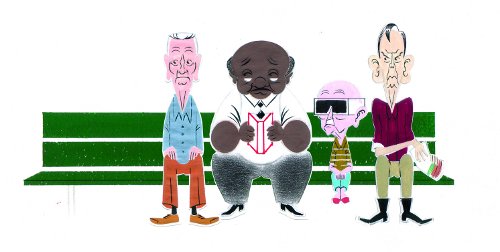
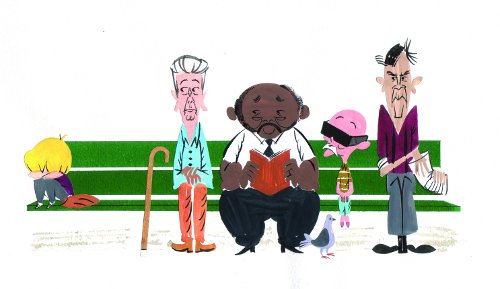
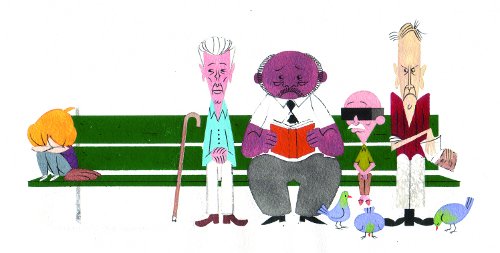
Author/illustrator David Small on Jane Yolen’s Elsie’s Bird (July 6, 2010):
“{This is} my land, my wife’s restoration of the tall grass prairie which used to end here, on this acreage, on the St. Joseph River. My inspiration for Elsie’s story:”
the hand holding the cage up above the high grass.”
(Click to enlarge spread.)
Author Jeanne Birdsall (October 14, 2010) on seeing Matt Phelan’s artwork for Flora’s Very Windy Day for the first time:
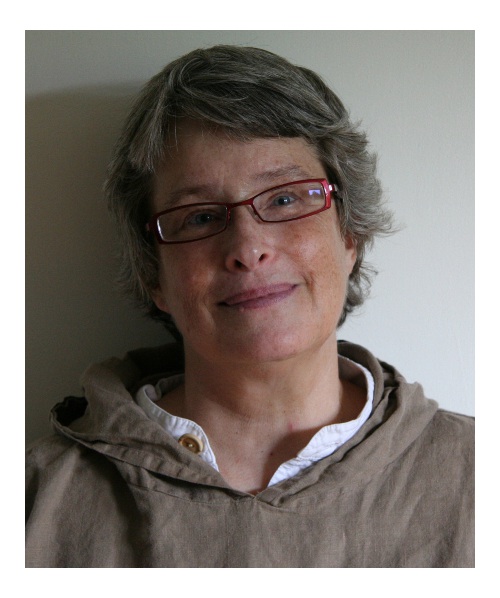
“I cried. Well, first I gasped a lot and stared googly-eyed at how simply gorgeous the art was. But there was much more to it than just beauty. I had written a story in which the action is driven by feelings, yet I couldn’t describe any of the feelings. I couldn’t say: Flora is torn between her desire to permanently rid herself of her little brother and her unconscious understanding that, though she doesn’t like him now, he could eventually grow up to be tolerable, like maybe by the time he’s twenty or so, and besides, she doesn’t want to turn into the kind of person who allows small children to be ripped apart by gigantic eagles.”
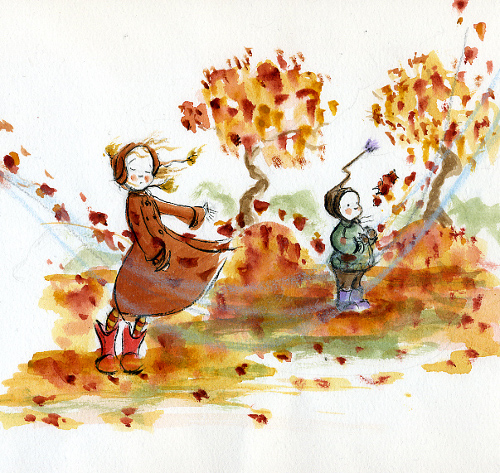
blasted mightily at Flora, but still she didn’t budge…”
Author/illustrator Matt Tavares (February 25, 2010): “I have never held my pencil the right way. Drove my 3rd-grade teacher crazy.”
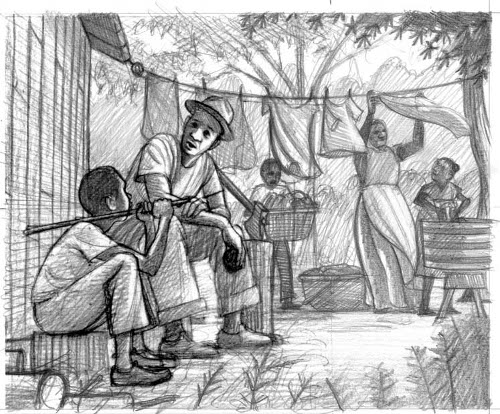
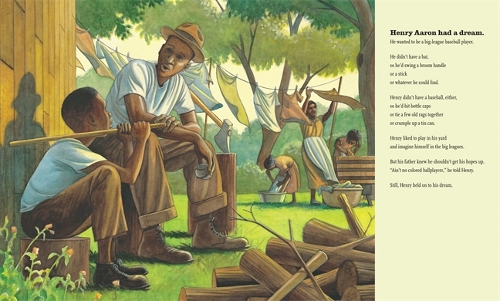
Poet J. Patrick Lewis (November 2, 2010), who was recently named the 2011 NCTE Poetry Award Winner:
 “A ‘prolific’ writer is one who might toss off books over the weekend as if writing were a holiday game. Only people who do not write children’s books can harbor such nonsense. Golf ball manufacturers, the makers of M&M’s, and paper shredders are prolific. I’d much prefer to be thought of as indefatigable…”
“A ‘prolific’ writer is one who might toss off books over the weekend as if writing were a holiday game. Only people who do not write children’s books can harbor such nonsense. Golf ball manufacturers, the makers of M&M’s, and paper shredders are prolific. I’d much prefer to be thought of as indefatigable…”
Author/illustrator Amy Schwartz (June 28, 2010): “It’s more often the case that I write my books over long periods of time — over months, if not years. I might begin by making a list of possible themes, of experiences related to my childhood or that of my son that have stuck in my memory. Then I might write out a secondary list of thoughts and events related to these themes. If I’m lucky, I may then have an idea of how to begin to shape a story. The memories by themselves, of course, are not enough for a successful text. I need a unifying idea, a story with a plotline or with some kind of organizing structure and sense of language that will form these memories into a satisfying picture book.”
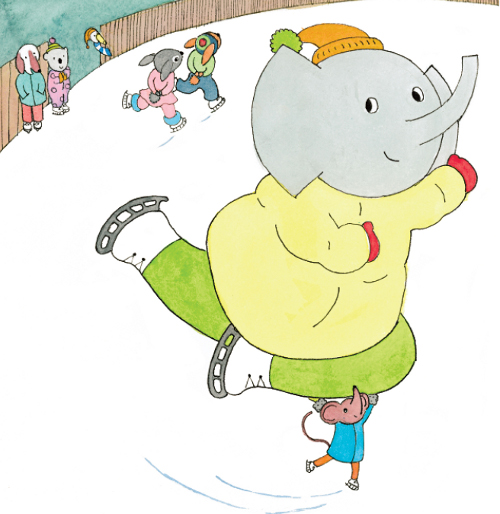
British illustrator Richard Holland (November 30, 2010):
 “Illustrating a picture book is a unique and very personal journey. From the challenge that the text offers and the first rough sketches through to the final artwork, you are always confronted by new problems to solve…Collage has a unique ability to surprise you. It’s a very old-fashioned medium, and I love the hands-on approach. The scale with which you cut out the object or the positioning on the page means that the spread can constantly evolve.”
“Illustrating a picture book is a unique and very personal journey. From the challenge that the text offers and the first rough sketches through to the final artwork, you are always confronted by new problems to solve…Collage has a unique ability to surprise you. It’s a very old-fashioned medium, and I love the hands-on approach. The scale with which you cut out the object or the positioning on the page means that the spread can constantly evolve.”
Author Jon Scieszka (September 2, 2010): “There is so much out in the news these days about the dismal state of education and how kids are not achieving. But I got to see die-hard booksellers, ecstatic librarians, turbo-charged teachers, and kids of all ages excited about stories…Kids, teachers, and librarians are wrestling with incredible changes in how information and stories are passed on. The blizzard of data from sources that weren’t even around five years ago is mind-boggling. Apps, posts, tweets, and videos…are taking eyeballs away from the older print media. But, while many people are wringing their hands and railing against this change, guess who is taking it in stride, leading the way into the 21st century, and teaching our kids how to be literate in all these new ways? Our teachers and librarians.”
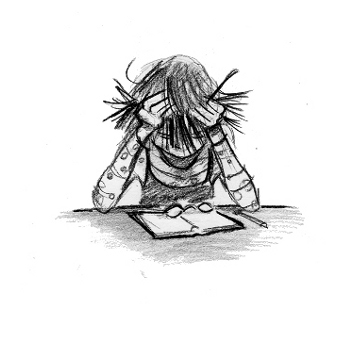 Author Anne Mazer, who was joined by author Ellen Potter, on Spilling Ink: A Young Writer’s Handbook, illustrated by Matt Phelan (July 13, 2010): “When we started the book, we envisioned it as solely for kids. We imagined it as a handbook for young aspiring writers, and we tried to make it so much fun that even kids who hated writing would want to do some of the ‘I Dare You’ exercises…We didn’t anticipate how enthusiastically classroom teachers would embrace the book. They have adapted our book in so many creative ways for elementary to high school classrooms. That has been immensely gratifying.”
Author Anne Mazer, who was joined by author Ellen Potter, on Spilling Ink: A Young Writer’s Handbook, illustrated by Matt Phelan (July 13, 2010): “When we started the book, we envisioned it as solely for kids. We imagined it as a handbook for young aspiring writers, and we tried to make it so much fun that even kids who hated writing would want to do some of the ‘I Dare You’ exercises…We didn’t anticipate how enthusiastically classroom teachers would embrace the book. They have adapted our book in so many creative ways for elementary to high school classrooms. That has been immensely gratifying.”
Author, poet, and gallery-owner Richard Michelson (October 19, 2010) on The New York Times declaring in October that the picture book is no longer the staple it once was: “…I have to say that visual literacy is as important as verbal literacy…Everybody should be reading picture books throughout their lives… The greatest illustrators do not just ‘illustrate’ the words of the page, thus narrowing our imagination; they bring their own creative vision to complement and expand the text. If the whole works, it is always greater than the sum of its parts…”

— From Richard Michelson’s Busing Brewster,
illustrated by R.G. Roth
Author Kathi Appelt, who was joined by author/illustrator Kelly Murphy, on Kelly’s artwork for Brand-New Baby Blues (February 23, 2010): “I especially love the way she uses the background colors. They remind me of the steel guitar chords that accompany a good blues singer. At the beginning of the book, Kelly paints it all purple, the color of royalty, and as the book moves forward, we can see the background changing, first to a kind of muddy brown, then to that green, green, greener which amplifies the disdain and envy that my young singer is feeling, the guitar is wailing now, until finally she begins to ‘lighten up,’ with the sunny yellows that infuse the last part of the book. And throughout, she has this kind of ‘cloud’ that swirls about, serving as a thread to bring the colors together. I thought it was brilliant.
What I hope for the book is that the readers sing it. Blues. They do a body good.”
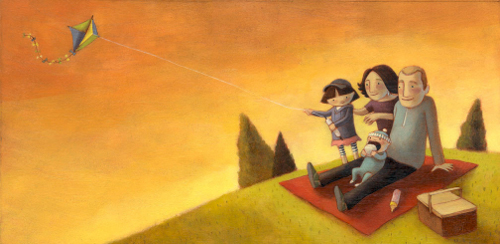
Author/illustrator Jarrett J. Krosoczka (June 21, 2010): “Fun Fact: Did you know that we chose yellow as the signature color for the Lunch Lady series because that is the color of a lunch lady’s rubber glove?”
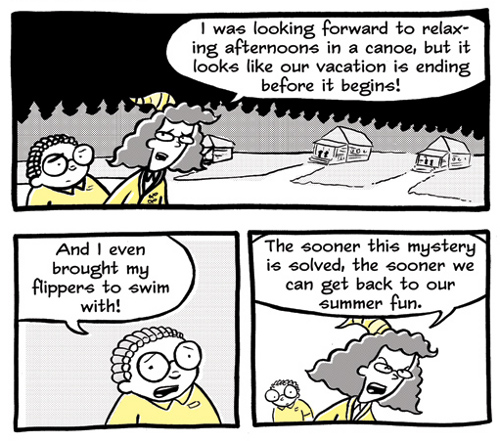
Author/illustrator Gianna Marino (August 3, 2010):
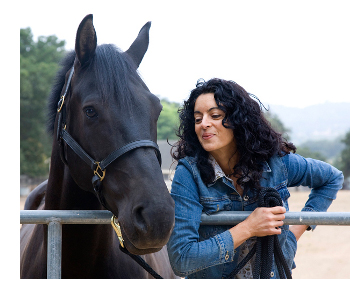 “Picture books are difficult to write. They seem so simple, but they are like poetry and every word has to tell its own story. I like to write descriptively and want to put in every detail into my story. I want to paint a picture with my words, but that is what the illustrations do. When I write picture books, I am constantly cutting out words, especially when I start the thumbnails.”
“Picture books are difficult to write. They seem so simple, but they are like poetry and every word has to tell its own story. I like to write descriptively and want to put in every detail into my story. I want to paint a picture with my words, but that is what the illustrations do. When I write picture books, I am constantly cutting out words, especially when I start the thumbnails.”
Author Barbara Bottner (December 21, 2010): “I love children for their frankness. When I visit schools, there is always some young child who will give me their unadulterated opinion on my books or tell me who they really love. They are more interesting to me than my die-hard fans. I love that children are bold and outspoken, so when I’m with them it strengthens my voice—it is a reminder of how fierce kids can be. They live in childhood; writers only visit.”

illustrated by Michael Emberley
Author/illustrator Tao Nyeu (April 6, 2010):

“I always come up with my stories inside-out. I set out drawing an image that I think is funny, and then I build a story around it. I can’t create a story if there is no inner chuckle. For example, in Bunny Days the seed of the book came from drawing the bunnies on the clothesline. Funny, right? After I drew it I had to figure out why they were there and how they got there. The words, if there are any, come last.”
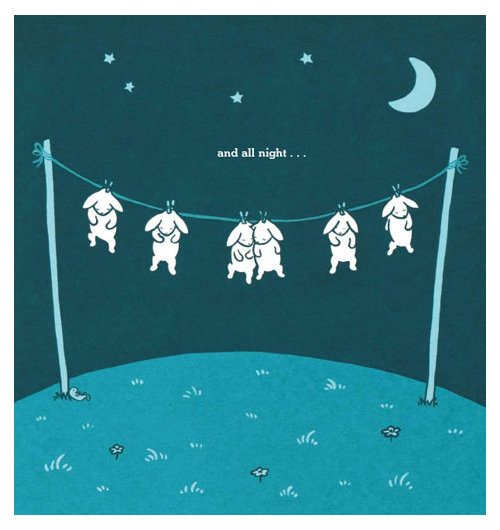
Author/illustrator Deborah Kogan Ray, who was joined by author/illustrator Lita Judge (July 8, 2010): “To me, the process of writing and illustrating a book is akin to movie-making. I adjust the plot. I look for ’shots’ that will expand the visual aspects of the story.”
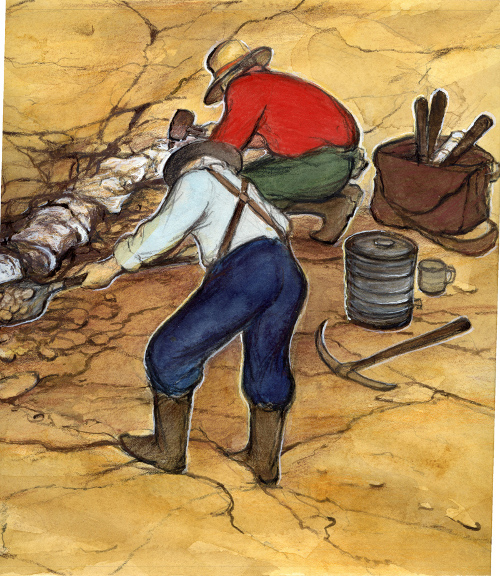
From Dinosaur Mountain: Digging Into the Jurassic Age
Illustrator / Maker-of-Things-By-Hand Extraordinaire Salley Mavor (December 7, 2010):
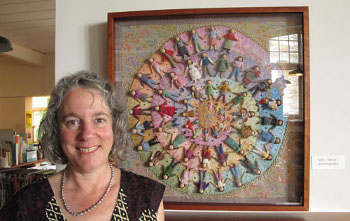 “While a student, I started making and selling a line of fabric pins. One day during class, I was listening to a critique, sewing some peapods, when my teacher, Judy Sue Goodwin-Sturges, noticed what I was doing. She looked more closely, asked me a few questions and said, ‘Why don’t you do this kind of thing for your illustrations? Try sewing them.’ With that simple encouragement, I stopped trying so hard to communicate the pictures in my imagination through a brush or pen. Given permission to work outside of the usual illustration mediums, I found that I was much happier and energized. I was no longer struggling to keep in step, but with a needle and thread I could dance. For some reason, I’d been under the impression that in art school, one does ‘serious’ fine art and I’d kept my interest in sewing and handcrafts underground. I rediscovered the joy of creating and learned to trust my hands and gut feelings to help work out challenges.”
“While a student, I started making and selling a line of fabric pins. One day during class, I was listening to a critique, sewing some peapods, when my teacher, Judy Sue Goodwin-Sturges, noticed what I was doing. She looked more closely, asked me a few questions and said, ‘Why don’t you do this kind of thing for your illustrations? Try sewing them.’ With that simple encouragement, I stopped trying so hard to communicate the pictures in my imagination through a brush or pen. Given permission to work outside of the usual illustration mediums, I found that I was much happier and energized. I was no longer struggling to keep in step, but with a needle and thread I could dance. For some reason, I’d been under the impression that in art school, one does ‘serious’ fine art and I’d kept my interest in sewing and handcrafts underground. I rediscovered the joy of creating and learned to trust my hands and gut feelings to help work out challenges.”
Author Mina Javaherbin (May 4, 2010): “I have always thought that the most personal experiences in life are the most universal ones, so if I aimed to address such a universal book, why not try the most personal angle? And so I did.”
(Click to enlarge spread.)
From Goal!, illustrated by A. G. Ford.
Author/illustrator Melissa Sweet (January 21, 2010):
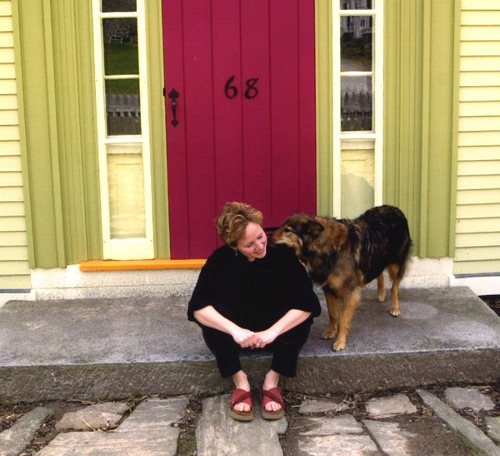
“Talking about the process reminds me of when I first went to New York with my portfolio. I met with Susan Hirschman at Greenwillow. She looked at one of my dummies, and I told her I knew it was rough, worrying I hadn’t done it right. She told me she wouldn’t want a dummy any more detailed. She suggested I let the final art be where I put my attention. I think that was advice I wanted to hear, but it also rang true for me as a painter. The art will dictate what it needs, and part of the fun is not knowing what it will look like in the end.”
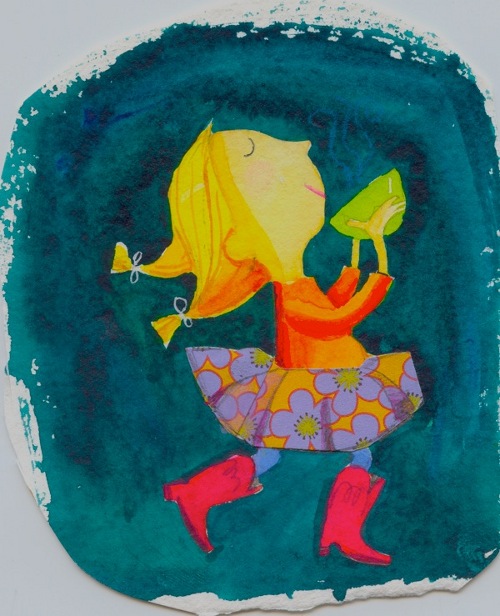
Author Andrea Beaty on how she came to write 2010’s Attack of the Fluffy Bunnies (June 8, 2010):
 “One day, I found myself annoyed by people who think that kids’ books should be sweet and cute and darling and nice. And, yes, they can (and sometimes should) be those things. Some of my favorite books ARE those things. But geez, Louise! These are the kind of people who think a character like Ted should be punished for messing things up instead of celebrated for being passionate and helpful, even if he does mess things up. Kids are smart and funny and capable of understanding so much. They are not less than adults but are their own magnificent beings with brains and funny bones…I decided that I should write a sweet and cute and darling and nice story. About bunnies. Bunnies are so darling. So, I started. After a minute, I thought it might be nice for the bunnies to be really big. After two minutes, I thought it might be nice for the bunnies to have fangs. After three minutes, I knew they were killer aliens which come to Earth to wreak havoc after a flaming meteor hits their marshmallow planet. Can you say s’mores? So much for writing a darling bunny book. On the other hand, I immediately got over being peeved and had the best summer of writing EVER!
“One day, I found myself annoyed by people who think that kids’ books should be sweet and cute and darling and nice. And, yes, they can (and sometimes should) be those things. Some of my favorite books ARE those things. But geez, Louise! These are the kind of people who think a character like Ted should be punished for messing things up instead of celebrated for being passionate and helpful, even if he does mess things up. Kids are smart and funny and capable of understanding so much. They are not less than adults but are their own magnificent beings with brains and funny bones…I decided that I should write a sweet and cute and darling and nice story. About bunnies. Bunnies are so darling. So, I started. After a minute, I thought it might be nice for the bunnies to be really big. After two minutes, I thought it might be nice for the bunnies to have fangs. After three minutes, I knew they were killer aliens which come to Earth to wreak havoc after a flaming meteor hits their marshmallow planet. Can you say s’mores? So much for writing a darling bunny book. On the other hand, I immediately got over being peeved and had the best summer of writing EVER!
The short version: I’m immature.”
Illustrator John Manders on Mary Nethery’s The Famous Nini: A Mostly True Story of How a Plain White Cat Became a Star (June 30, 2010): “The colors are inspired by the paintings John Singer Sargent created while living in Venice.”
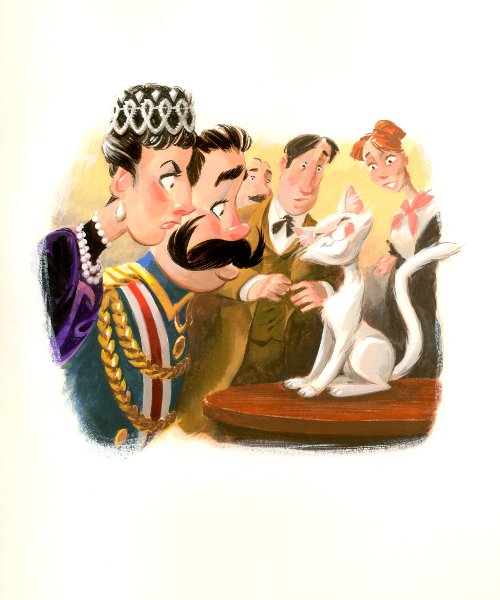
Horn Book editor Roger Sutton, who was joined by executive editor Martha V. Parravano, on A Family of Readers: The Book Lover’s Guide to Children’s and Young Adult Literature (October 28, 2010): “The problem with a book like ours is both what you have to leave out and what you hadn’t yet seen — the books just keep on coming, thank goodness…”
Author/illustrator Julian Hector (June 2, 2010): “I came up with The Gentleman Bug in the fall of 2004, while daydreaming in a Feminist Artist class at Parsons — with slides of Jenny Savilleʼs obese female nudes on the projector screen. I had no idea what the story was going to be about, but I thought that ‘The Gentleman Bug’ could make for a nice book title, and I liked the idea of a male ladybug wearing a top hat. I usually start my stories this way: Iʼll come up with a character, realize that Iʼm drawing it over and over again, then decide that itʼs time to give the character a voice, place it in a conflicting situation, and share it with people. This drawing was the eureka moment that the brought the story together”:
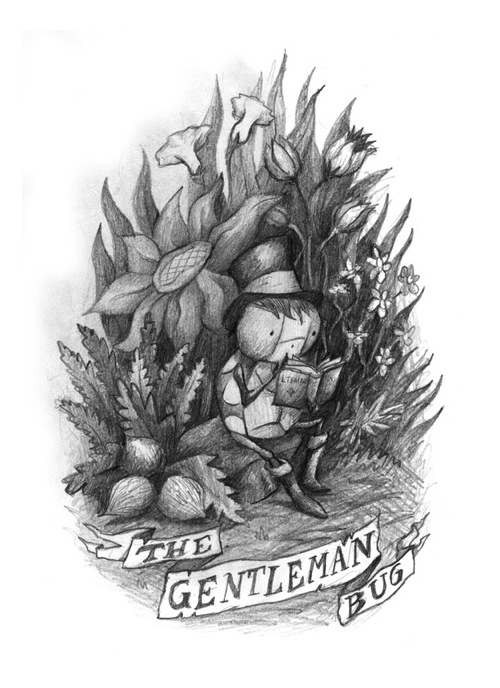
Artist Scott Teplin on working on The Clock Without a Face with Mac Barnett, Eli Horowitz, Adam Rex, and Anna Sheffield (April 27, 2010): “This project was very different. I was forced to draw things that didn’t come naturally to me, and instead I had to do research to figure out how something was supposed to look, a method I’ve since embraced in my studio (when I’m not feeling lazy). That’s one great thing about working collaboratively — it forces me out of my comfort bubble, and in the end I learn quite a bit.”
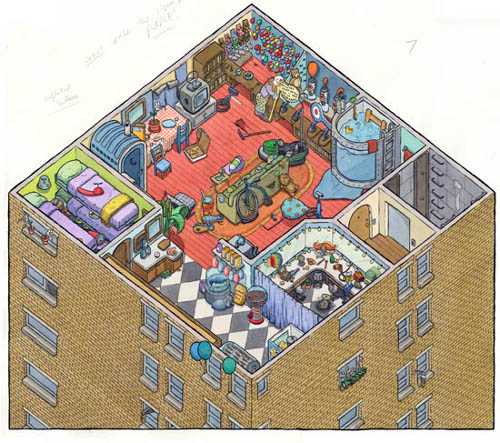
Author/illustrator Stephen Alcorn (January 14, 2010): “Teaching has proven beneficial to me as an artist, as it forces me to articulate verbally with concision and clarity the creative processes I employ and develop intuitively in the privacy of my studio. I find that this verbal articulation fosters a greater clarity and economy of means in the formal, stylistic, and symbolic statements I seek to make as a craftsman, as a visual artist.”
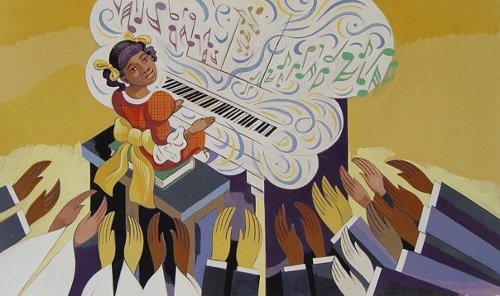
Author Ellen Weiss on The Taming of Lola: A Shrew Story (July 20, 2010): “{T}he book was written quite a long time ago, but poor little Lola had been in a sort of cryogenic state at Abrams for years, because they couldn’t find the right illustrator. Then I happened to meet Jerry Smath socially, and when he told me he had a book that had just come out from Abrams, I told him Lola’s tragic tale. He said, ‘Send it to me, and I’ll see what I think.’ About a week later, he called me up and said that he’d loved it and had done sketches for the whole book, and did I want to see them. (Nah…) I totally adored them, as any sane person would.”
eating bugs and worms and whatnot all day long.”
(Click to enlarge.)
Author David Elliott (November 16, 2010): “No matter what I’m writing, I’m trying to demonstrate for young readers the power and the beauty, the resilience and the play in their language. I hope that doesn’t sound too high-falutin’. Understand, too, I’m not saying I always succeed, but it is something I try to be conscious of as I work…I sometimes think of prose picture books, at least the ones I like, as eggs. Really nutritious. Really simple. And really strong. You know that thing about trying to break an egg by placing each end in either palm and squeezing? You can’t do it. But if there’s a crack in the shell, you’d better have your dry cleaner’s number handy. That’s what I aim for. No cracks. I love the challenge of writing a picture book for the very young. It’s terribly difficult, at least for me, but satisfying if I can get it right.”
“As lovely as the antelope, / as lovely and as fast, / but Antelope / is always first / and Zebra always last. / They say that’s just the ordered way, / unchangeable, and yet /
I wish we had, / for Zebra’s sake, / a different alphabet.”
(Click to enlarge slightly.)
Author/illustrator Carin Berger, who stopped by on May 27, 2010, to share some art from March’s Forever Friends: “I am illustrating a book called The Green Mother Goose by Jan Peck and David Davis (for Sterling Publishing). {Here are} two pics of one of the illustrations as it’s being created.”
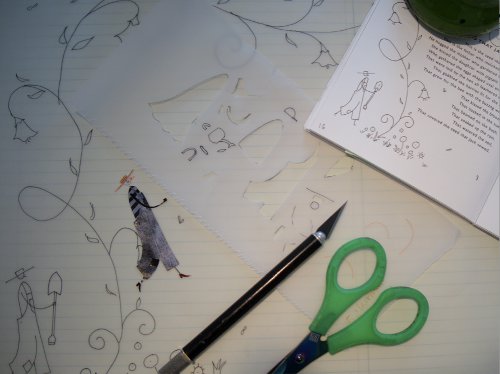
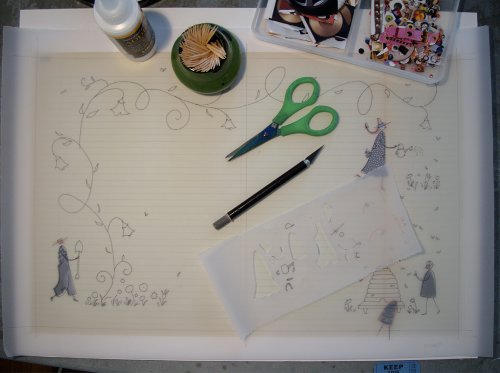
Author Lesley M. M. Blume on what comes after Modern Fairies, Dwarves, Goblins, and Other Nasties: A Practical Guide by Miss Edythe McFate (September 15, 2010): “David {Foote} and I are now turning our sights on the ancient world: our next book will be a collection of rather wild fables about extinct, fantastical creatures that once roamed the earth. Most of them are quite peculiar and even defy imagination — but they still offer important lessons about our world today.”
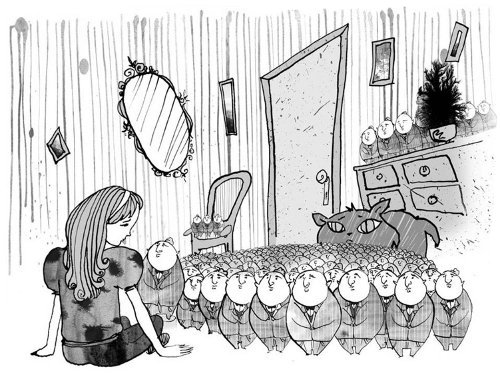
Author/illustrator Barney Saltzberg (March 26, 2010): “I don’t ever remember re-working drawings for any of my other books, the way I did for this one. I have piles and piles of different versions of the same illustration.”
as filled with my favorite responses from 2010:
7-Imp: What is your favorite word?
A three-way tie between Scott Teplin’s “slather,” Matthew Reinhart’s “cheesecake,” and the respect Oliver Jeffers has for the very under-appreciated “the.”
7-Imp: What is your least favorite word?
A two-way tie between Julia Denos’s “cute” and Andrea Beaty’s “behave.”
7-Imp: What turns you on creatively, spiritually or emotionally?
Joyce Sidman: “Sunshine.”
7-Imp: What turns you off?
A two-way tie between Andrea Beaty’s “a lack of absurdity” and Jeff Newman’s “small talk.”
7-Imp: What is your favorite curse word? (optional)
Oliver Jeffers: “C*** ******** *** dumpster.”
(Runners-up: Andrea Beaty’s “the hyphenated one” and J. Patrick Lewis’s “Limbaugho’reillybeckhannitysavagepalin.”)
7-Imp: What sound or noise do you love?
Jennifer L. Holm: “Quiet.”
(Runners-up: Peter Brown’s “Lester Young’s saxophone” and Scott Teplin’s “When my son tells me he has a secret for me — and then he crunches a pickle an inch from my ear. It’s very satisfying.”)
7-Imp: What sound or noise do you hate?
Jeanne Birdsall: “I won’t tell you, because then I will be in your power.”
7-Imp: What profession other than your own would you like to attempt?
Amy Schwartz: “Independently wealthy philanthropist.”
7-Imp: What profession would you not like to do?
Jeff Newman: “Sign-holder, as in the guy that holds a sign outside Little Caesar’s in the freezing cold, advertising two large pizzas for ten dollars. God bless that man.”
7-Imp: If Heaven exists, what would you like to hear God say when you arrive at the Pearly Gates?
Jeff Newman: “I blessed the Little Caesar’s guy for you.”
(Runners-up: The very pragmatic “Dinner’s ready!” from Tao Nyeu and “just ‘hi’ would be fine” from Christopher Wormell.)
Every Sunday at 7-Imp is still devoted to featuring the work of an illustrator, the first Sunday of the month for student or new-to-the-field artists, and here are some of my favorites from this year. (Okay, so there are a lot here. I have trouble picking favorites, but—again—this post is for browsing.)
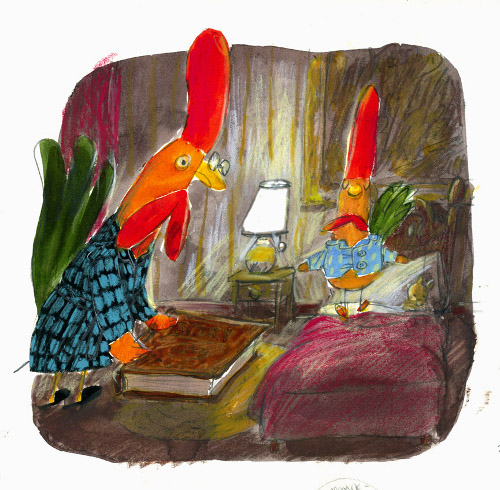
Featured on June 13, 2010.
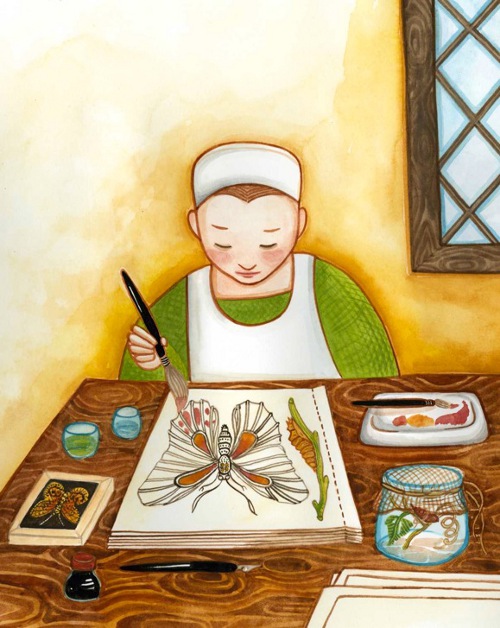
I write down everything the summer birds do.”
From Margarita Engle’s Summer Birds: The Butterflies of Maria Merian,
illustrated by Julie Paschkis.
Featured on March 21, 2010.
From author/illustrator/graphic novelist Paul Hoppe’s The Woods,
to be released in Spring 2011 by Chronicle Books.
Featured November 14, 2010.
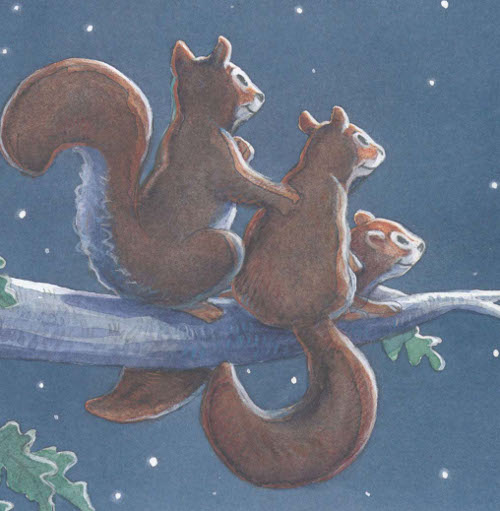
Scottish poet James Guthrie’s Last Song.
Featured on September 26, 2010.
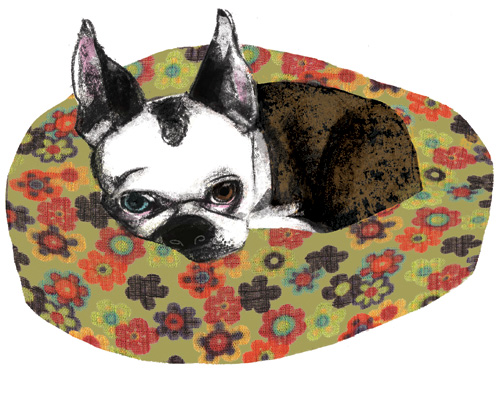
Featured February 28, 2010.
I am scared too.”
(Click to enlarge spread.)
From Renée Watson’s A Place Where Hurricanes Happen,
illustrated by Shadra Strickland.
Featured on August 22, 2010, along with illustrator Sean Qualls.
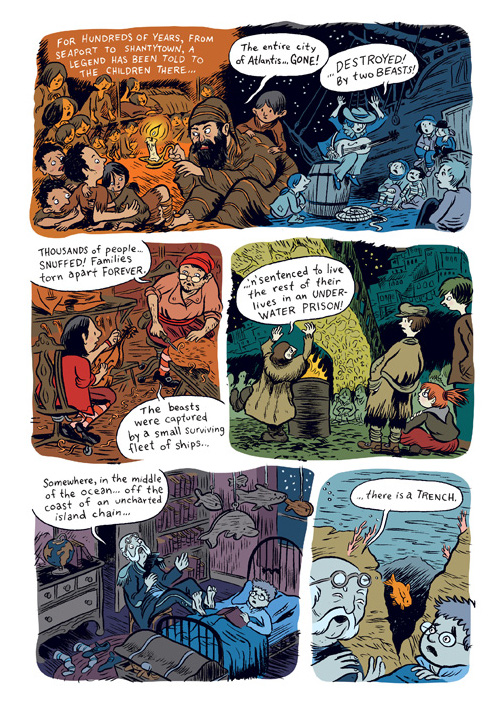
Featured on September 19, 2010.
(Click image to enlarge.)
From Philip C. Stead’s A Sick Day for Amos McGee,
illustrated by Erin E. Stead.
Featured on June 6, 2010.
(But don’t forget this ’09 post, in which Erin first introduced us to Amos, this fabulous book, and the tools she used to create it.)
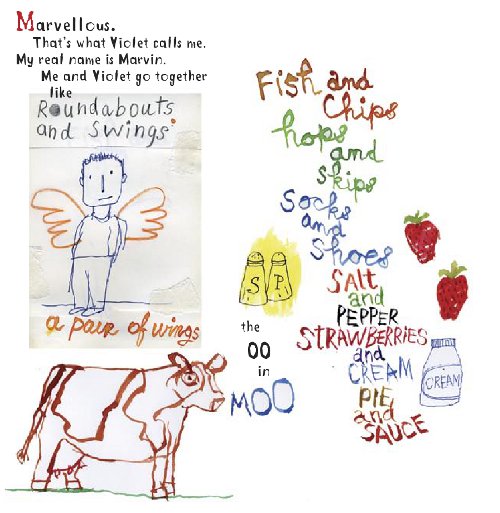
Featured on October 17, 2010.
down the East Coast of America…”
(Click to enlarge spread.)
From Jonah Winter’s Here Comes the Garbage Barge,
illustrated by Chris Sickels of Red Nose Studio.
Featured on March 28, 2010.
Free as the wind through the trees…”
(Click to super-size spread.)
From Gary Golio’s Jimi Sounds Like a Rainbow (Clarion Books, October 2010), illustrated by Javaka Steptoe.
Featured December 12, 2010.

From Jen Cullerton Johnson’s Seeds of Change,
illustrated by Sonia Lynn Sadler.
Featured on August 8, 2010.
Featured on November 7, 2010.
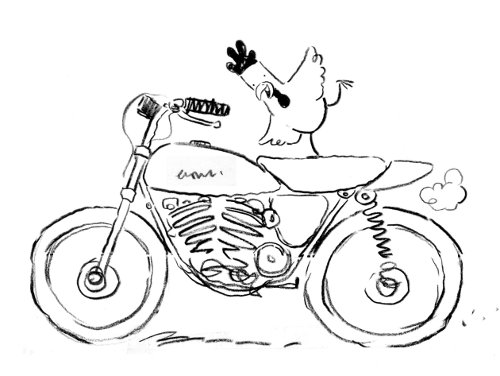
Featured on May 16, 2010.
a feeling of hope spreading from garden to garden.”
From Katie Smith Milway’s The Good Garden: How One Family Went from Hunger to Having Enough (Kids Can Press, September 2010),
illustrated by Sylvie Daigneault.
Featured November 21, 2010.
illustrated by father-daughter team Marije Tolman and Ronald Tolman.
(Click to enlarge spread.)
Featured on August 15, 2010.
Red Roses aren’t things to dread / Unless they’re white and you are dead. /
No justice done, no tears to shed / The judgment’s in: Off with her head!
From local (to me) illustrator Janet Lee’s Alice’s ABCs, which at that time was in the hands of her agent.
Featured March 7, 2010.

From Jacqueline Woodson’s Pecan Pie Baby, illustrated by Sophie Blackall.
Featured on October 3, 2010.
(Click to enlarge each.)
Featured on August 29, 2010.
(Click to enlarge.)
Featured on January 24, 2010.
And some of my favorite illustrations from the year, which just have to make a presence in this post:
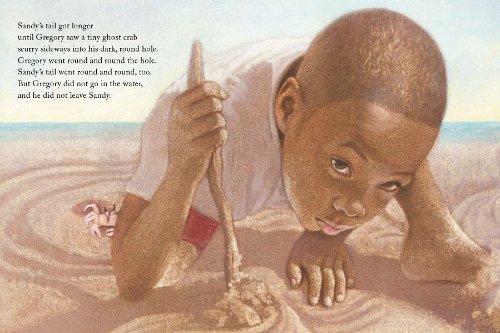
From Karen Lynn William’s A Beach Tail, illustrated by Floyd Cooper.
Featured on September 19, 2010.
(Click to enlarge spread.)
From Deborah Underwood’s The Quiet Book, illustrated by Renata Liwska.
Featured on April 22, 2010.
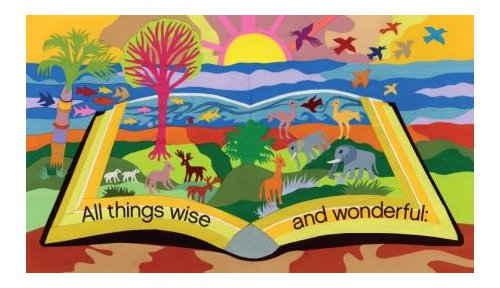
“All Things Bright and Beautiful.”
Featured on August 26, 2010.
illustrated by Josée Masse.
(Click to enlarge and see reverso, too.)
Featured on March 4, 2010.
(Click to enlarge spread.)
From Shelley Jackson’s Mimi’s Dada Catifesto.
Featured on April 28, 2010.
(Click to enlarge spread.)
From Carolyn Parkhurst’s Cooking with Henry and Elliebelly,
illustrated by Dan Yaccarino
Featured on November 4, 2010.

Featured on August 17, 2010.
(Click to enlarge.)
From Jacqueline K. Ogburn’s A Dignity of Dragons: Collective Nouns for Magical Beasts, illustrated by Italian illustrator Nicoletta Ceccoli.
Featured on April 13, 2010.
up in that thicket of thorny thieves.”
(Click to enlarge spread.)
From Anne Isaac’s Dust Devil, illustrated by Paul O. Zelinsky.
Featured on September 21, 2010.
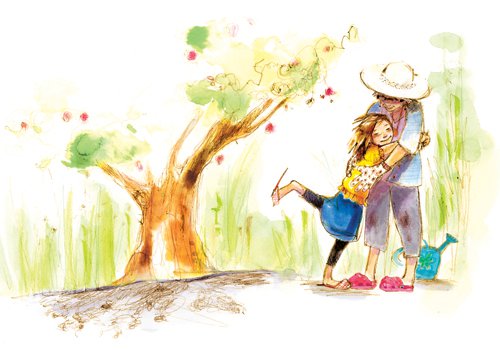
From Cecil Castellucci’s Grandma’s Gloves, illustrated by Julia Denos.
Mes jeunes filles!'”
(Click to enlarge spread.)
From Cheryl Willis Hudson’s My Friend Maya Loves to Dance.
Featured on June 23, 2010.
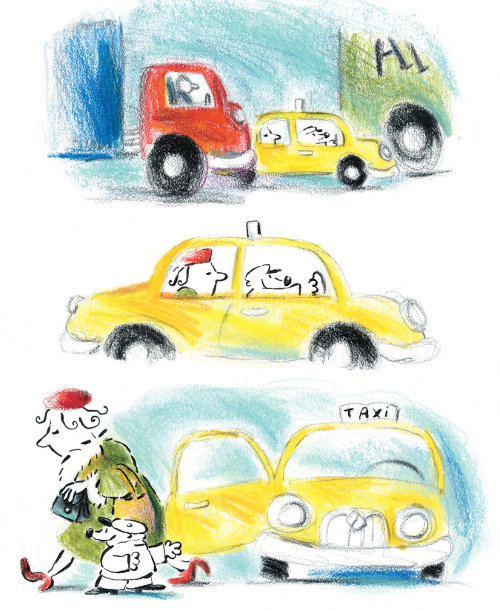
Featured on March 1, 2010.
Copyright note: If I were to list all the copyright notices for these images here, well, you’d find me slumped over my keyboard. Here’s my plea: Please be cool, current and potential readers, and remember all rights reserved and all that good stuff. Also, in all instances the original copyright notices for the image or artwork you see should be listed at the post (interview, feature, what-have-you) from which the above snippets come, since I’m a stickler about including copyright info. If you link back to the original post for many of these, you will see copyright notices. Bottom line: Don’t steal. These weren’t mine to begin with. I had to ask to get them, so please do the same. Thanks.
As a reminder, ALL (not just 2010) of 7-Imp’s author interviews are archived here at the site, and all illustrator/artist interviews and features are archived here. I also always update those lists, ’cause I’m a big nerd like that.
The mysterious and slightly grouchy-looking Alfred (he’s really a softie, I swear), who opens this post, is © 2009 Matt Phelan. Alfred grinds my coffee in the mornings before I post and as I set the table for my guests.
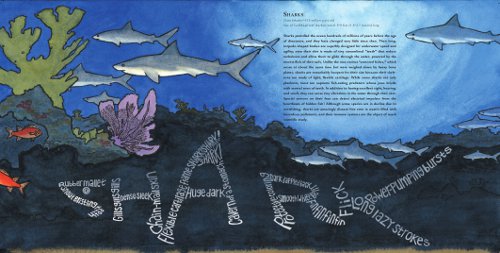
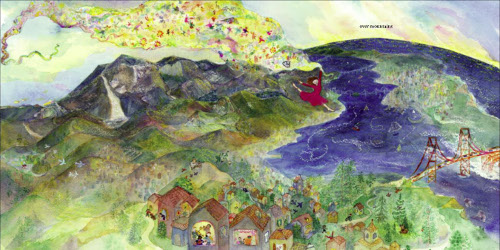
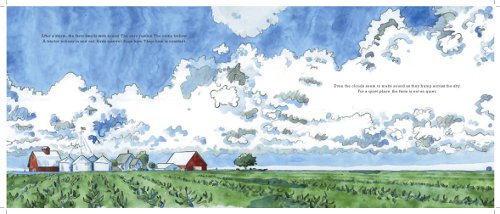
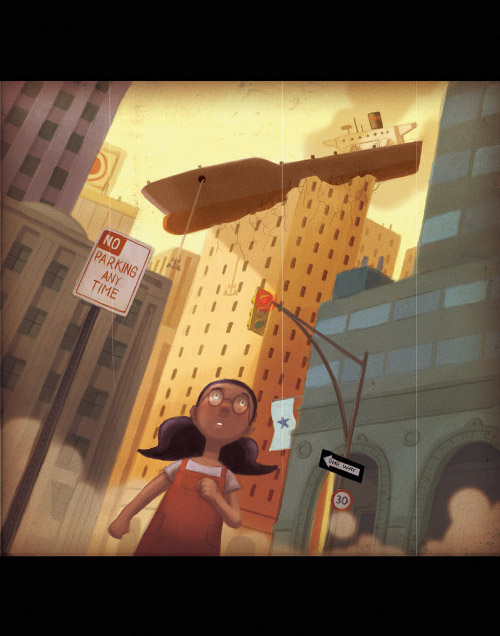

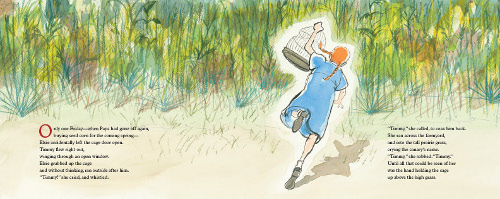
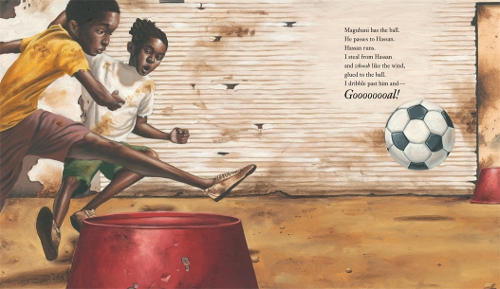
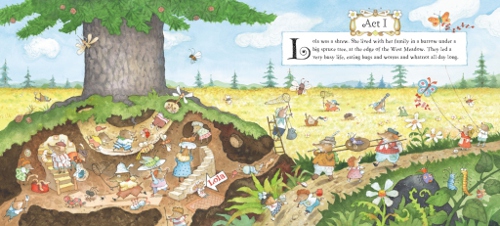
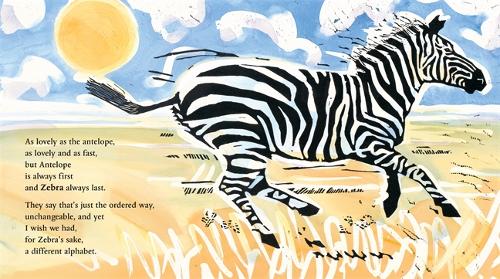
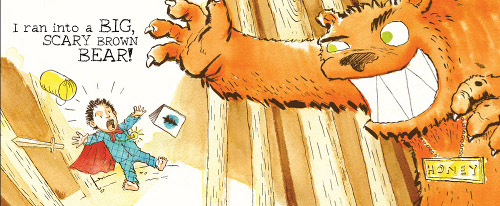
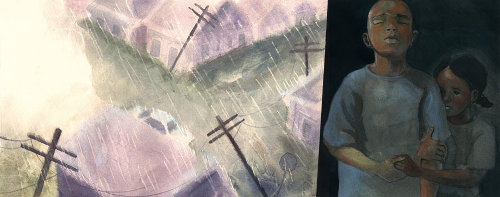
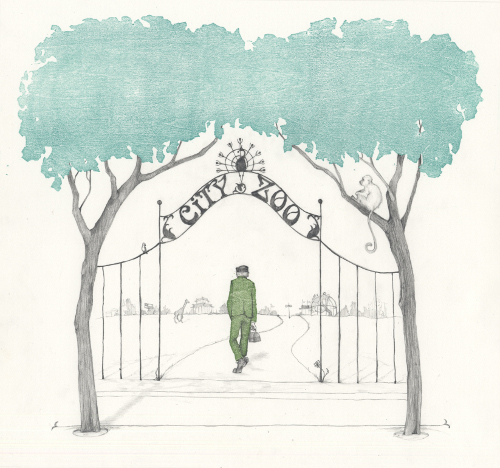
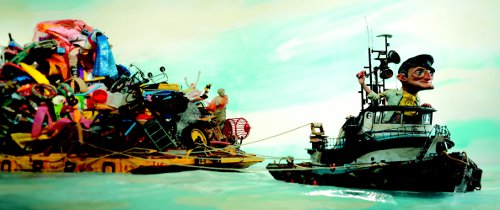
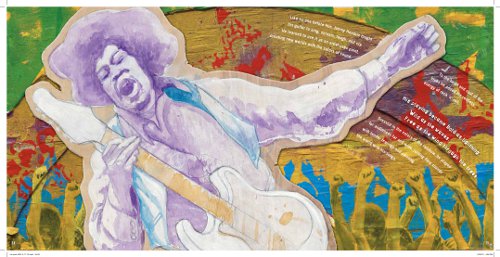
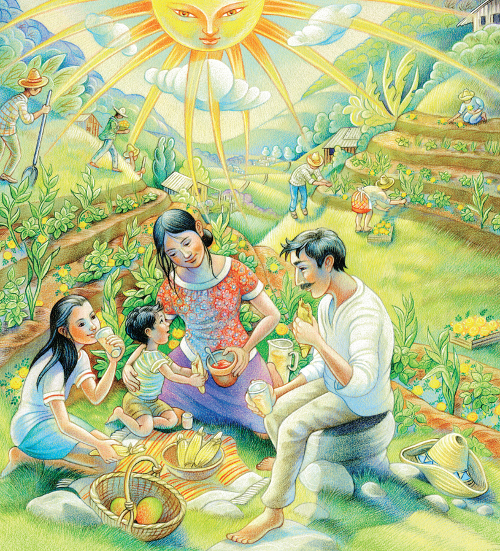
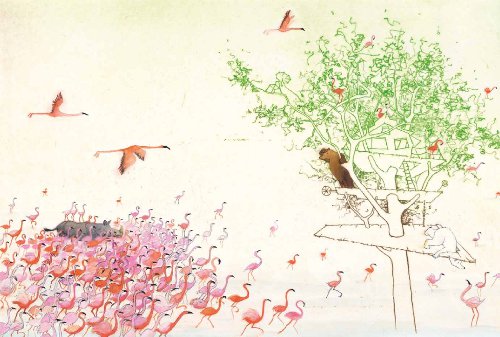
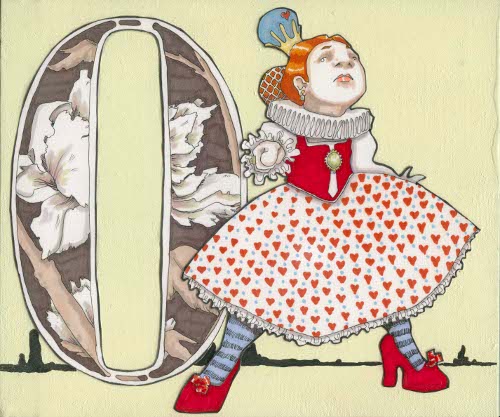


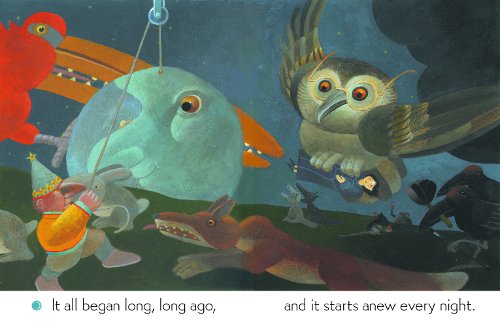
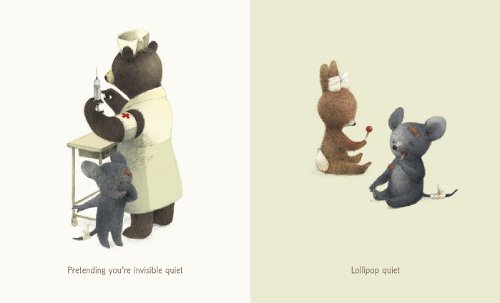
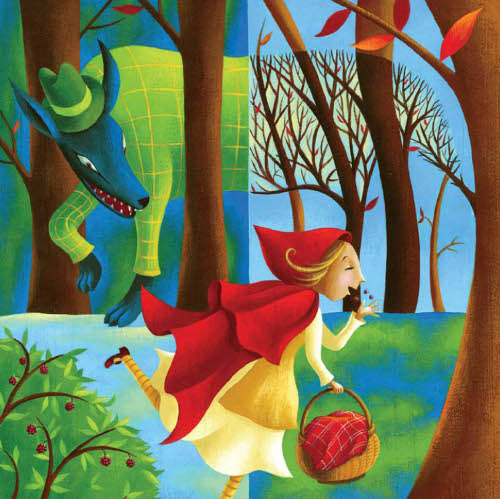
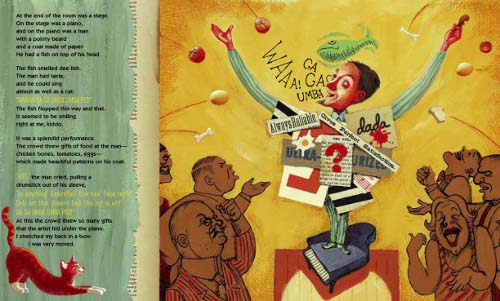
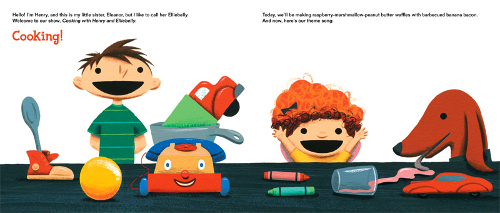

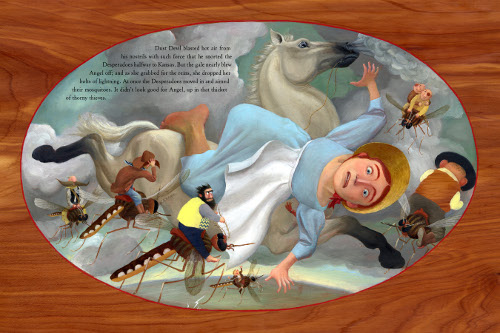
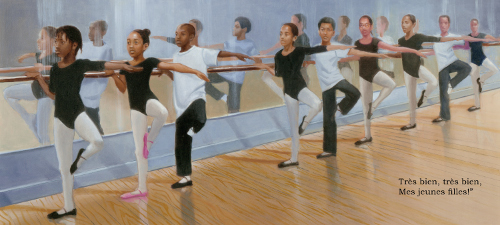

Jules, what a feast of imagination and talent you have assembled here! You have made this work so accessible! I feel as if I’m in an art/lit bakery and I could consume everything in the display cases! In this crazy world, there is a corner where all is new and wonderful and there is still play and improvisation and delight. Thank you!
Just tired looking through it all. I mean–with all those words, you could have finished a novel this year instead!
Happy New Year, dear Jules.
Jane
What a great way to start the day and the new year.
So many of my favorite books from this 2010 are here.
So inspiring! Happy New Year.
Melissa
Amazing! Well done, Jules.
Wowza! What a book bonanza — only you could have put together such a magnificent feast of awesome. Hard to believe you had “a little less time for blogging.”
Happy New Year!
WOW! What a wrap-up! Thanks so much for all of your time and dedication!
So that’s where the year went — savoring all this amazing work. And worth every minute. This post, like so many, brought me such cheer. Thank you, Jules!
Jules–this is amazing! Thanks so much for putting this all together. What a gift!
xoK
Nice. Love seeing people I don’t know. Anne Villeneuve and Susan Gal are great pics. Must check them out…Will get a post for you soon….
I want to add my “WOW” to the chorus. A mighty big wrap up, and still just a taste of 2010 at 7imp. Great work Jules. All the best in 2011!
Gorgeous! Stunning! A feast for the eyes and the imagination. Thank you, Jules.Looking forward to the riches of 2011.
Makes me happy to see so much great stuff in one long post!
Happy New Year.
Jules! Wow! So many of my favorite books, authors and illustrators. What a wonderful way to end the year.Thank you! Happy New Year–and here’s to more wonderful work in 2011.
Oh, Jules, bravo! This was an amazing holiday gift. I can’t wait to see what 2011 has in store for all of us!
Thank you again for a year of inspiration (all in one place). I always forward to your new posts. And now I look forward to another year full of them. Happy New Year!
Jules,
What a monsterously, fabulous year it has been. Congratulations.
Awesome recap, Jules! Some awesome books and art this year, and very glad to have you here to represent.
Thanks again, Jules! It’s like Christmas all over again.
Frank
So inspiring – what diverse images and interviews! Just what I needed right about now.
Thank you – Jules and everyone – for a fantastic year!
Jessica
Thank you for the super re-cap, Jules. Definitely a labor of love. What a great way to end one year and begin another…
Fantastic epic post!
And I do think there’s a Caldecott up there! My money’s on FLORA’S VERY WINDY DAY.
Happy New Year to all!
Cheers!
You amaze me yet again!!!
Thanks for putting this together all year, and pulling it all together to celebrate the end of the year. I appreciate that you bring us together into a community, and that you make it such a celebration. Happy New Year!
Julie
I’ve discovered such wonderful, inspiring creations on this blog – thanks for another year of devotion to the picture book!
Wow what an incredible collection. I have only recently discovered this blog – and so excited to visit it regularly in 2011. Happy New Year! x
Thanks, you all. I enjoy doing it and appreciate the nice words. But it’s your art and your musings that make it so beautiful.
I like what Julie P. says about community. One of the reasons I enjoy doing this is that there are not a ton of blogs that focus on solely picture books/illustration (compared to something like YA lit blogs). Let’s stick together. We need our high-quality picture books.
Wow. You do such important and wonderful work.
Whoa. The tremendous effort and love that went into putting this 2010 retrospective together is really beautiful, Jules. You amaze me, all the time. The children’s lit world has a real champion in you, and I hope you are incredibly proud of this blog. It’s a magical place to visit.
[…] Seven Impossible Things Before Breakfast a blog about books « One Impossibly Crazy2010 7-Imp Retrospective Before Breakfast […]
Amazing collection of interviews and artwork featured here, Jules. Thanks for all that you guys do here on Seven-Imp! Here’s to another fantastic year!
Thank you.
ThankYOU! This is such an important post – I can’t wait for its arrival each year. SevenImp is an indispensable site, and these recap posts are worthy of visiting over and over again. I can’t imagine how much time it takes to pull the recap together, but I thank you!
Thanks again, nice people. Aaron, congrats on the new addition to the family!
Beautiful, Jules. Just a splendid walk through the year.
Thank you for doing so many wonderful things and introducing me to so many great artist and writers. Have an incredible new year!
I’ve had an excellent time reading through this blog, Jules. There aren’t many webpages I’m willing to get a numb ass (from sitting so long) over…but your’s is well worth the loss of circulation to my cushy parts. Thank you for taking the time to write such notable notes!
Hee. Thanks, Debbi… and everyone.
[…] Actually, I just really enjoy end-of-the-year recaps of every kind, and—as I said in 2010’s recap post—this is my warped idea of tidy fun. Also, it satisfies the tremendous picture book junkie in […]